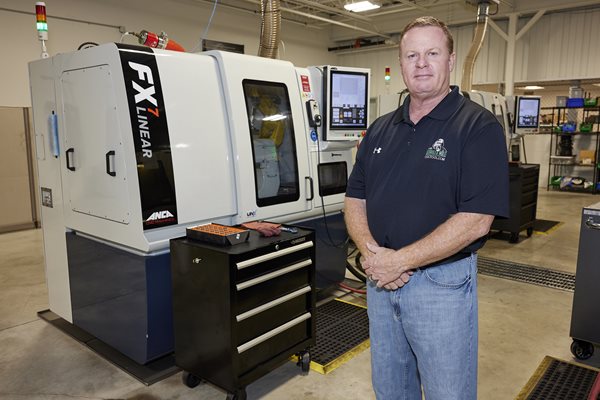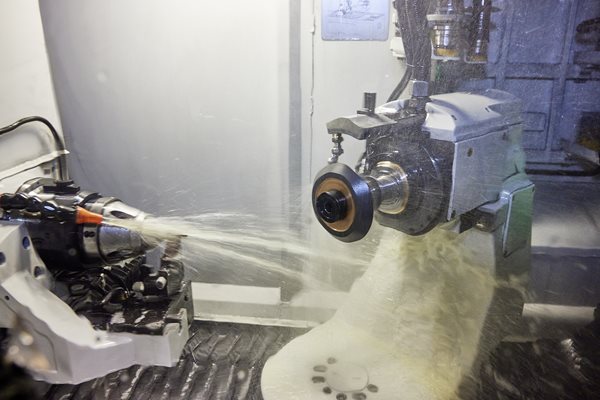Il bollettino E The Sharp
Gennaio 2022
Carbide Grinding Company Inc, fondata nel 1974, si è guadagnata un’ottima reputazione come piccola realtà specializzata nella fabbricazione di utensili che rifornisce i produttori dell’area di Milwaukee del calibro di Snap-on e Harley-Davidson.
Dopo aver rilevato l’azienda nel 2003 e rinnovato la sua immagine due anni più tardi trasformandola in Gorilla Mill, simpatica e aggressiva, come la scimmia raffigurata sul marchio di fabbrica e lo slogan che recita “Armi di produzione di massa”, Kevin Cranker ha diretto l’azienda su un solido percorso di crescita.

Attualmente conta circa 48 dipendenti, con 300 distributori in tutto il mondo e una clientela molto varia,
tra cui figurano fornitori del settore automobilistico e della difesa, clienti del settore aerospaziale come Boeing e SpaceX e Blue Origin in ambito spaziale.
Ma, a quanto pare, sono i piccoli negozi a conduzione familiare a dare le più grandi soddisfazioni a Cranker.
“Sono loro che mandano avanti la baracca”, spiega.
Se uno dei pezzi grossi ci lascia, ci restiamo un po’ male. Ma alla fine abbiamo tante piccole aziende a conduzione familiare con cui amiamo lavorare, perché ci restano sempre fedeli e continuano a comprare da noi.”
Cranker racconta che ANCA CNC Machines ha svolto un ruolo importante nei progressi compiuti da Gorilla Mill.
Dopo aver investito ed essere rimasto deluso da macchina rettificatrice per utensili e frese prodotta in Europa nei primi anni del Duemila, ha deciso di provare una RGX, adatta alla riaffilatura per volumi ridotti di produzione.
La macchina fa ancora parte della collezione di macchine ANCA di GM, alla quale se ne sono aggiunte altre 17.
“Ne ho comprate abbastanza regolarmente un paio all’anno qui negli ultimi cinque o sei anni. Probabilmente me ne servirà ancora qualche altra prima del 2022.”
“Abbiamo diverse RX7. Alcune MX7. Un paio di TX7. E ora abbiamo anche un sacco di FX7. È un mix di ogni genere di modelli vecchi e nuovi. Adoro i nuovi modelli con i motori lineari che funzionano a meraviglia.”
Cranker paragona la differenza tra i motori lineari realizzati da ANCA Motion e il movimento delle viti a sfera a quella tra “il giorno e la notte”, in termini di maggiore precisione e velocità e una durata molto prolungata nelle officine in cui si generano notevoli residui di carburo.
Il pioneristico software di simulazione di ANCA è stato un altro ausilio fondamentale, che ha eliminato tutti i rompicapo e le seccature del design delle geometrie delle frese Gorilla brevettate a quattro e cinque scanalature, progettate da Cranker assieme a Mark Greenwood.
La ditta ha adottato la simulazione con l’acquisto della sua seconda macchina ANCA e ne apprezza la straordinaria utilità sin da allora.
“Il team di GM ha rapidamente riconosciuto il valore dell’ANCA 3D CIMulation nella sua assistenza per il design e lo sviluppo di nuove geometrie di utensili senza dover rettificare alcun utensile fisico,” sottolinea il direttore generale di ANCA Inc Russell Riddiford.
“Il design ottenuto viene quindi inserito nella macchina ANCA e si ottiene direttamente da lì il primo utensile esattamente come lo si è progettato nella 3D CIMulation.”
Sullo sviluppo degli utensili, Cranker aggiunge che “non ce la potrebbe mai fare” senza la 3D CIMulation.
“Abbiamo avuto la possibilità di sperimentare e pasticciare con le geometrie in un ambiente virtuale senza spreco di materiali, tempo della macchina e tutto il resto,” spiega.
“E oggigiorno il simulatore è migliorato così tanto con tutte le nuove aggiunte e il fatto che ora ci si possono disegnare modelli e fare molto altro.”
Una caratteristica del software che usiamo regolarmente è il bilanciamento degli utensili introdotto in ToolRoom RN34. Questo si è dimostrato di grandissimo aiuto, specialmente per le frese a scanalatura singola, consentendo di progettare utensili per la lavorazione ad alta velocità senza rumore né vibrazioni che non danneggiano i manufatti.
Anche il livello della facilità d’uso e delle opzioni di automazione disponibili sulle macchine ANCA è cresciuto assieme a Gorilla Mill.
Il “cross training” richiesto per il personale in rapida crescita è minimo e la maggior parte dei macchinari dell’officina utilizza lo stesso software di ANCA.
“In più, abbiamo tutte le nostre macchine collegate in rete”, aggiunge Cranker.
“Possiamo semplicemente manipolare i percorsi e i programmi utensile nel simulatore e poi riprodurre il tutto su qualsiasi macchina su cui servono.”

Ogni macchina è dotata di un caricatore robotico, che può essere di tipo pallet o un’unità AR300 più recente, e ci aiuta a rendere possibile la produzione senza presidio. Di giorno si lavora alla produzione personalizzata e a breve termine. Il terzo turno non è presidiato.
Con la crescita del personale e delle entrate per l’azienda, che sono aumentate quasi del 900 per cento dagli inizi di Gorilla Mill, Cranker prevede di continuare ad investire in macchine FX e MX e nelle opzioni di robotica abbinate.
“Attualmente siamo in grado di realizzare 3500 frese a codolo di notte, se necessario, e per noi è tantissimo, commenta Cranker, che ricorda i tempi in cui l'azienda muoveva i primi passi nell’automazione con la vecchia macchina RGX.
“Può essere difficile quando non si sa come installare tutto per bene, e ANCA ha fatto un ottimo lavoro per cercare di ridurre al minimo le complicazioni. Ma anche noi abbiamo affinato le nostre capacità e ogni volta che abbiamo fatto un passo avanti abbiamo acquistato un nuovo caricatore, perché ho la ferma intenzione di realizzare gli utensili senza presidio.”
13 gennaio 2022